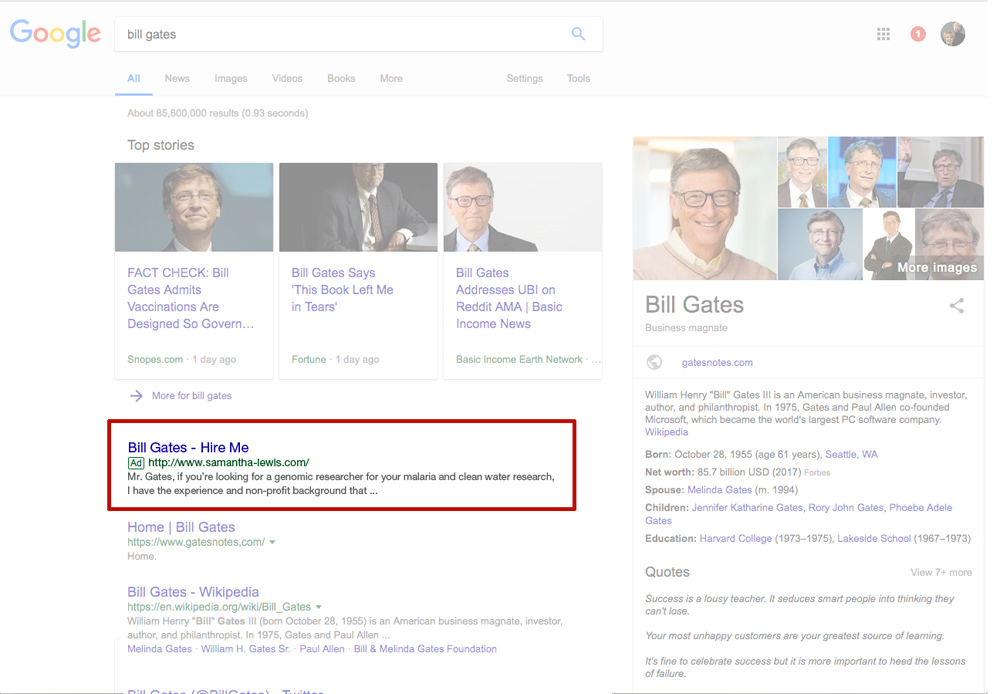Everyone knows there's a lot of competition finding jobs, especially in anything technology- or research-related. And it's hard to get your name in front of the head of any large organization.
As a humble Columbus OH website design firm, we're going to share an idea can help you get your next job, or next client.
Back in 2010, a copywriter named Alec Brownstein, came up with a creative way to get the attention of creative directors in some of New York City's top advertising agencies, which you can read about here.
Below is a fictitious screen shot of how Alec's idea would work today if you were trying to get, say, Bill Gates' attention. Highlighted in the screen shot below is a fake Google Ad that shows what it would look like if someone bought the keyword "Bill Gates" and ran an ad looking to get hired.

How it works
This approach is based on the fact that (almost) everyone Google's themselves at least occasionally. However, that's especially true for people in positions of power. Maybe not for Bill Gates, but if you know the name of the man or woman in the top spot of an organization you want to work for, that's step one:
- First, find out the name(s) of the people who are the owners, or can make hiring decisions at, the company you want to work for.
- Next, start an account at Google AdWords. If you already have a gmail email account, you're one step closer (because you need that in order to start your AdWords account).
- Bid on the keyword that is the name of the individual you want to reach. Below is an example of what a Google AdWords matrix would look like.
(See the notes below the screen shot for a more detailed explanation of what this screen is about.) - Run the ad for as long as it takes for the targeted person to click the ad.

Number 1 shows the keyword (an individual's name) you theoretically have "bid" on.
Number 2 shows the max amount per day you're willing to spend. More on that below.
Since no one really buys people's names as keywords, you could probably get away with something as little as $1.00 a day. And even then, you'd probably never spend the $1.00 if no one clicked on the ad. It's your hope that the only person who is going to click on the ad is either the person whose name it is, or a close associate.
The two numbers that affect the AdWords cost:
- First is the amount you have to spend every time someone clicks your ad. Google tells you how much you need to spend based on how competitive that keyword is. In the screen shot below, you'll see Google tells us, you'll need to pay 5 cents per click for the keyword "Bill Gates." (So you can imagine how cheap it would be to buy someone else's name who ISN'T Bill Gates.)
There looks like LOTS of searches for Bill Gates' name every month (8,100) so lots of people must be doing research on him. But your target person wouldn't have nearly as many searches on their name, since they're not Bill Gates. You'd have to hope, however, that no one would mistakenly click on your ad thinking it's an actual informative website about the person you're targeting. The problem is, only half the people using Google know the difference between ads and organic results. And as a side note, teenagers aren't any better. So there's a good chance people will mistakenly click on your ad. But at 5 cents (or less) per click, it's not a big expense.

- The second number you need to think about is the budget per day. (See two screen shots above, with the red number 2 on it.) That number shows the daily maximum expense you're willing to pay.
Essentially, when enough people click your ad (at 5 cents per click, 20 people would have to click the ad before you reached $1.00), your ad goes away for that day. And it starts over the next day.
So you could spend $1.00 a day for several days before your targeted person actually clicks your ad.
Of course, you'll need a website for that person to go to.
When your target clicks your ad, you want them to go somewhere that has information about you (or your company). So you'll need to have a website, even if it is a simple one.
Almost anyone can build a simple 2- or 3-page website using SquareSpace, so make sure you have an impressive enough website waiting for the person you're targeting to visit. That website would give them more information about why you (or your company) is the best person (or firm) to work with them.
Think about this if you're looking to get the attention of someone. If they're in a position of authority, power, or responsibility, there's a good chance they'll Google themselves at some point. And when they do, your ad will be waiting for them.
Good luck digitally targeting your next prospect!








